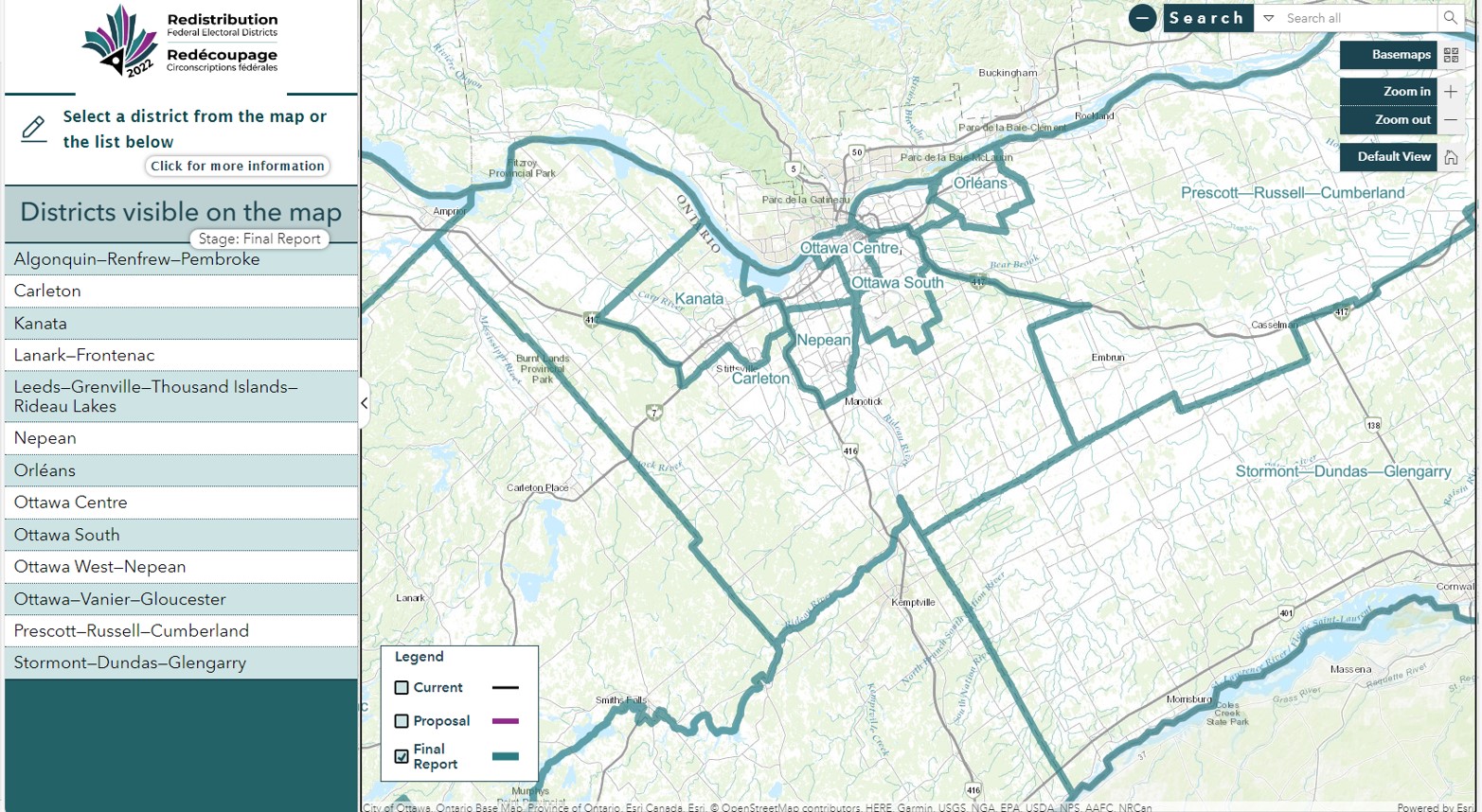Any dissolution of Parliament on or after 23 April 2024 will mean that Canadians vote in a general election using the new electoral boundaries established in 2023. The House of Commons grew from 338 to 343 MPs, with Alberta gaining three new MPs and British Columbia and Ontario each gaining one new MP.
Section 51(1) of the Constitution Act, 1867 requires that the number of MPs per province be recalculated after each decennial census and, consequently, that the electoral boundaries of ridings within each province be readjusted every ten years. Parliament redrew electoral boundaries directly from the 1870s to the 1950s. But since 1964, the Electoral Boundaries Readjustment Act provides that independent Federal Electoral Boundaries Commissions, one for each province, decide where and how to readjust electoral boundaries in a non-partisan manner. Each commission is chaired by a judge and consists of two other members appointed by the Speaker of the House of Commons. The commissions release an initial proposal, hold public hearings throughout the province on that proposal, and then release a preliminary report based on what they learned from anyone who commented either for or against the proposal. MPs then study the preliminary reports and make recommendations on changing either the names or boundaries of ridings, which the commissions must consider but may (and usually do) reject in their final reports. Those final reports then become the Representation Order, a piece of secondary legislation that the Governor-in-Council promulgates under the Electoral Boundaries Readjustment Act. Those Representation Orders enter into force for a dissolution of parliament seven months later. This gap of seven months gives Elections Canada time to prepare for the next general election under the new boundaries, such as by making new maps of all the ridings, identifying polling divisions within each riding, and appointing or re-appointing Returning Officers for all ridings the boundaries of which changed.
In 2021, the Chief Electoral Officer published the calculation on section 51(1), which showed that the House of Commons increased overall from 338 to 343, with Alberta having gained three new MPs and British Columbia and Ontario each having gained one. The Federal Electoral Boundaries Commissions for each of the ten provinces began their work on 9 February 2022 when Statistics Canada released the population and dwelling counts for each province and each of the 335 provincial ridings established under the previous electoral redistribution in 2013, and they completed their work at various points from late 2022 to mid-2023. The Governor-in-Council issued the Representation Orders, 2023 on 23 September 2023 as part of the Proclamation Declaring the Representation Orders to be in Force Effective on the First Dissolution of Parliament that Occurs after April 22, 2024. Today, 23 April 2024, marks the first day after 22 April 2024 and therefore means that the new electoral boundaries have entered into force and will apply in the next general election – whenever that happens.
You can view the new maps of your riding here on Elections Canada’s website, by province and by riding. You can look at the new maps on the website of Redistribution 2022 in more detail as well, zooming in and what not, by following the links for “The Commissions” and the “Map Viewer,” selecting “Final Report” in the latter.
Unfortunately, any by-election during the remainder of this 44th Parliament (which must dissolve 36 to 50 days in advance of the polling day scheduled for 20 October 2025) would have to occur under the old electoral map of 338 ridings established under the Representation Order, 2013. Elections Canada therefore has to maintain the two sets of electoral maps until the 44th Parliament is put out of its misery. That said, I think that Elections Canada’s website could better explain this distinction that it currently does, because a by-election called after the new electoral boundaries take effect would also have to use the boundaries from 2013 instead of those from 2023. Only a general election can reset everything.
I worked as a Senior Analyst in the Electoral Redistribution Directorate of Elections Canada from November 2021 to March 2024 and therefore feel a great sense of relief that even if the Prime Minister choses to advise the Governor General to dissolve the 44th Parliament earlier than 36 to 50 days before the election schedule for October 2025, we will vote along the new electoral boundaries on which the Federal Electoral Boundaries Commissions worked so hard and for which my colleagues and I at Elections Canada provided logistical and administrative support.
Incidentally, the Canadian Parliamentary Review will soon publish my article “Adjusting Federal Electoral Boundaries in Canada: Redistribution 2022,” and I have also been working on another larger project on Redistribution 2022 and will let you know when I can provide more information on that.
Similar Posts:
- The Gerrymander of 1882 (January 2024)
- British Columbia & Ontario Would Each Already Gain 1 MP(December 2023)
- Bowden, J.W.J. “The Ever-Expanding House of Commons and the Decennial Debate Over Representation by Population.” Journal of Parliamentary and Political Law 17, no. 1 (2023): 85-122.
- Readjusting Electoral Districts in Federations: Malapportionment vs Gerrymandering (August 2022)



All your posts are a cut above what comes my way, much of it paid for. Thanks and regards, David Hutchinson
>
LikeLike
Pingback: Out With The 338 & In With The 343: The New Federal Electoral Boundaries Just Entered into Force Today! – Showing Gratitude to Your Clients That Is Beyond the Thank-You Note.
Congratulations! It’s all thanks to you!!!
Rand
LikeLike